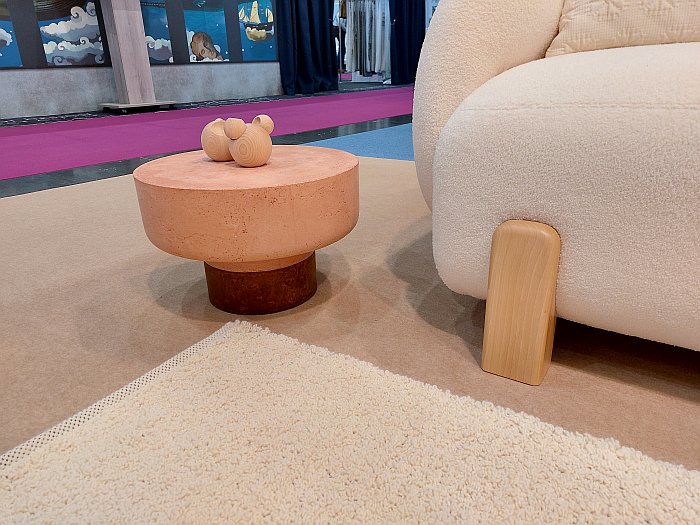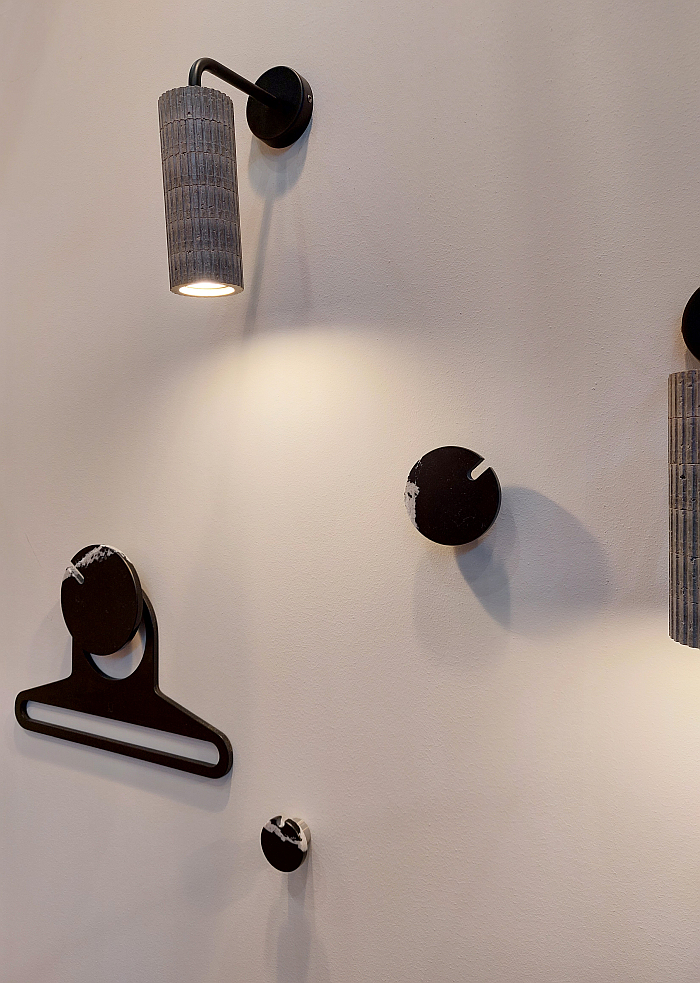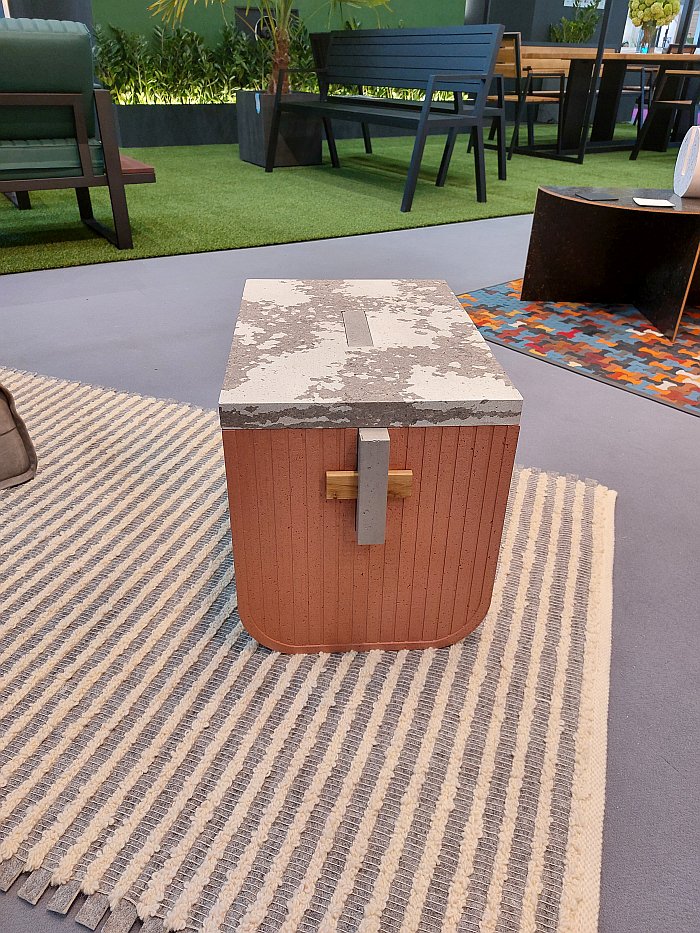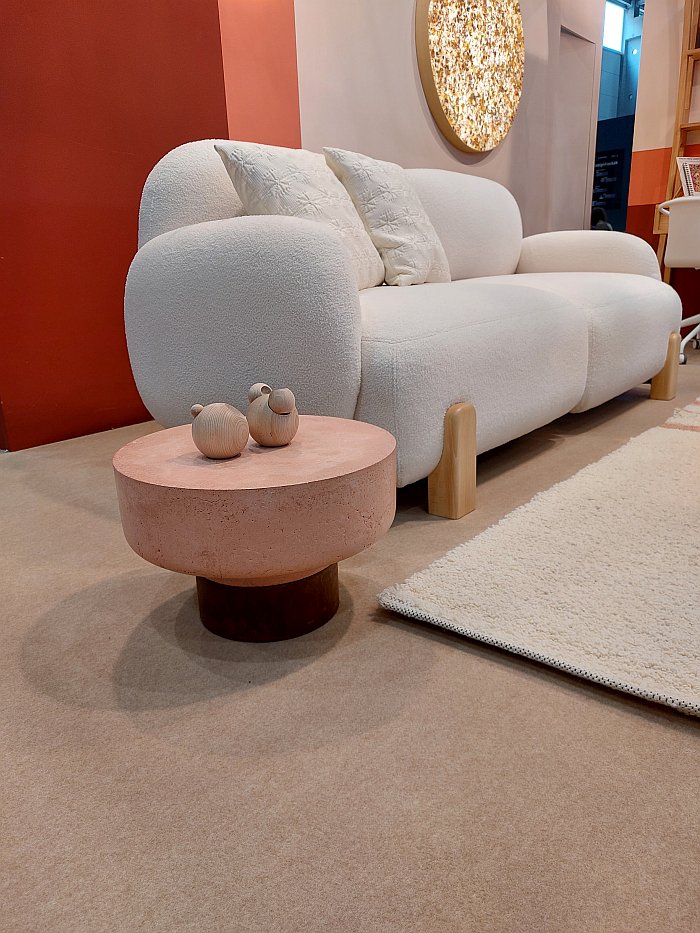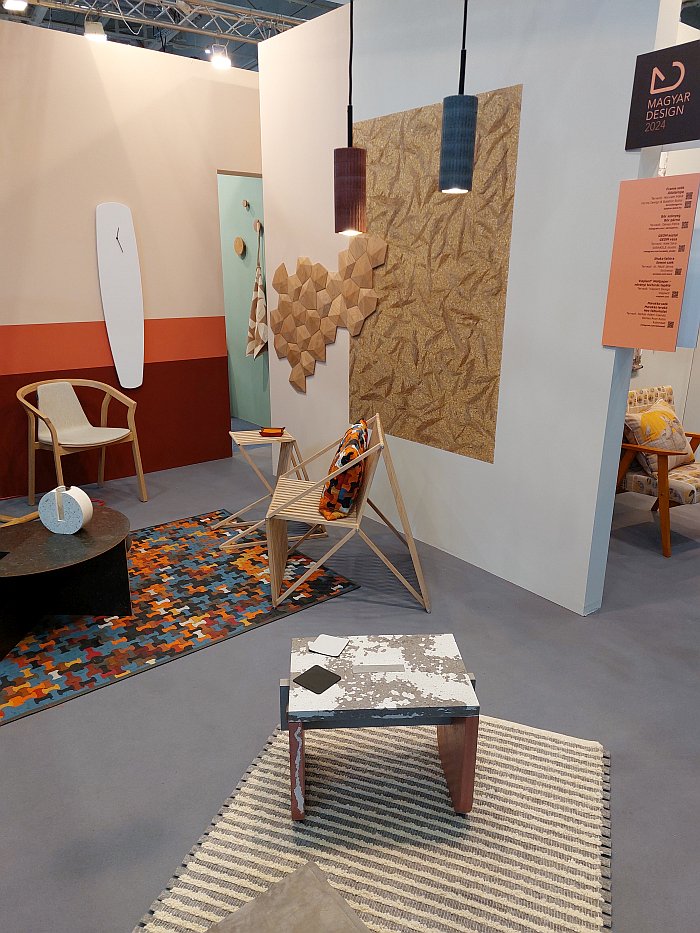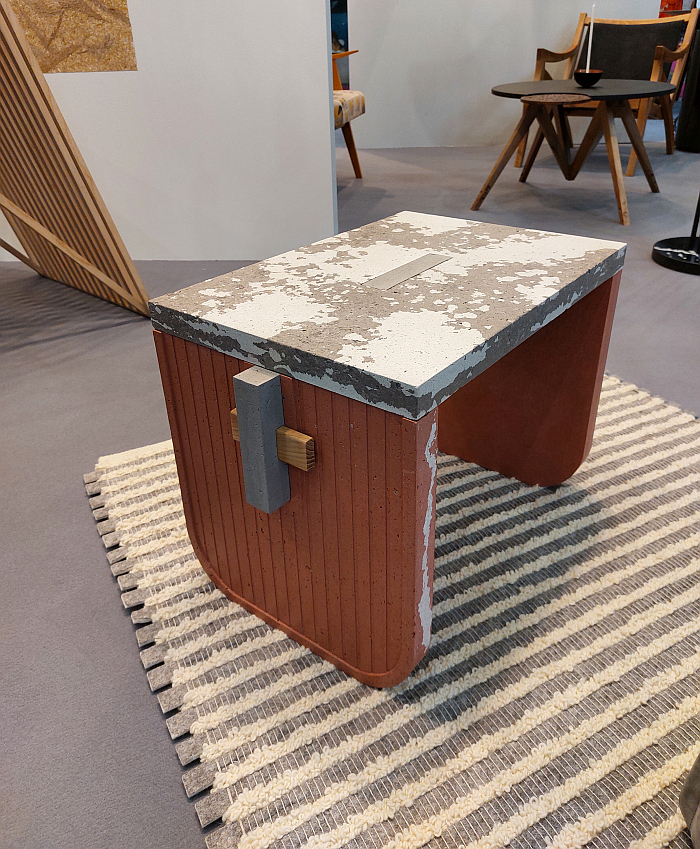
The first thing that drew us to Paper-Up a.k.a Rita Koralevics' occasional table was the construction: the small wooden batons on the side implying it was possibly worth taking a closer look. So we did. And it very much was. Didn't disappoint. Revealing as it did a deliciously simple, efficient, unhurried, construction principle that actively contributes to not only the stability but to enabling the form. A form that, having got up close and personal with the object to explore the construction, you then appreciate in a more nuanced manner, find yourself drawn in to the subtleties of a form that initially appears incongruous, but which on closer inspection reveals itself to be incongruous. Belligerently so. Invitingly so. Satisfyingly so. Much like the 1980s it references, but has no interest in being; just as the 1980s referenced previous eras without wanting to actually be them. It may be plug'n'play, may be proudly analogue, may be, is, garish, but it knows the 1980s are as far behind us as the 1880s. And knows that that is good so. Similarly while it has an affection for, and appreciation of, inter-War Functionalist Modernism, it doesn't believe that was an end, rather understands, and argues, that it was but a component of an ongoing debate it wishes to be an active component of, and in wanting such draws you in to a conversation you didn't see coming when you first spotted the small wooden batons.
By which point we were pretty much hooked.
And then we were told it is made of paper.
Which, yes, is kind of obvious from the name of the brand: Paper-up. But, in our defence, the signage at Magyar Design was only in Hungarian, not one of our strongest languages, and we had no idea we were looking at a Paper-up product, we were just thoroughly engrossed in an occasional table, an occasional table we thought crafted from some kind of concrete, or stone, or terrazzo material, it certainly had and has the correct visual characteristics and tactility, that dull sharpness of light, and cold warmth of touch of concrete, stone, terrazzo, et al
But it is paper
OK not just paper. Rather a material that was described to us as 'paper concrete', an exact description of whose ingredients we've been thus far unable to locate, but whose trail we are on, even if we suspect Rita Koralevics guards the recipe as closely as Messers Lea & Perrins guard that of their Worcestershire Sauce; but which we suspect, not least based on those snippets of information we have found, is a paper pulp mixed with an adjunct, if one so will is an extreme form of papier-mâché. Which, we suspect, is a phrase Rita may not approve of us using, but in the interests of time and space, and not knowing the actual recipe, is, we'd argue, valid as a simplification. And one we'll need in a couple of minutes. And regardless how one describes it, it is a fascinating example of, demonstration of, recycling in action. But we'll say more about the material once we know more about. If we're ever allowed to know more about it.
And having discovered Paper-up through the, as best we can ascertain, unnamed occasional table, we subsequently spent a lot of our time at Magyar Design with the other Paper-up, Rita Koralevics, works on show.
With the Column lamps, wall and pendant variations, works which, we're assuming, are associated with a work that appears to be called Random Gear, a name we're assuming from the form that reminds very much of gear works, but whose groves also, and for us primarily, remind of the marks left by stone cutting, stone extracting, machines and processes, and thereby plays very nicely with their visual similarity with stone, add to the impression that what you are seeing is pieces of stone stacked on top of one another to form a lamp. A deception that isn't made by Rita but which you yourself formulate in your preconceptions; is a deception that occurs in your brain, not in Rita's studio.
And also with the Wabi Sabi lerakó, whereby, and digressing slightly from the subject at hand, 'lerakó', according to our translator, interpreter, means dump, disposed, landfill. And not 'table', or 'sofa table', as is implied by the object at hand. Is that so? Or do we need to hire ourselves a new translator/interpreter? 'Lerakóasztal', we're informed, is folding table. But if 'asztal' is table, what is 'lerakó'? And what is 'lerakó' in context of Wabi Sabi lerakó?
Yet regardless of such linguistic challenges, Wabi Sabi lerakó is and was truly wondrous thing. An utterly joyous thing.
And a very heavy thing. Which confused us, it's paper....... until we saw the metal foot. A metal foot that once discovered not only completes the visual composition, sets contrasts and correspondences, allows one to engage with it on the complexities of wabi-sabi in our digital age, but transforms the 'paper concrete' top part into a table top. Which is important. And a metal foot that may, or not, we don't know, have been added to a work known as Disk we stumbled across on one of Rita Koralevics' internet presences that resembles the top part of Wabi Sabi; if it is the case, if Wabi Sabi lerakó is a further development of Disk, we very much approve, although we reserve the right to change that opinion if we ever meet Disk. But Disk will have to be very good. Which it wouldn't surprise us if it was, based on the evidence of the Paper-up collection we have seen.
And the more time we spent with the the Paper-up collection, both at at Magyar Design and subsequently online, the more irritated, frustrated, we became that we hadn't been introduced to it earlier.
And there were chances.
For Rita Koralevics established Paper-up in 2012, and featured at Vienna Design Week 2014, that fateful edition where we were introduced to 'Candlestick' by Budapest based collective AU Workshop, a life changing moment. Genuinely. We've never been the same since. We know, a candlestick!! Had we also been introduced at Vienna Design Week 2014 to Rita Koralevics and Paper-up, we may have moved to Budapest. Having decided it was an enchanted garden, where the rivers flowed in beer, the leaves on the trees were crisps, pandas thrived, under-7s made all the important decisions, and designers intrinsically, inherently knew how to realise meaningful, responsive, functional objects in a manner that not only improved the lives of all but didn't unduly inconvenience, harm or impinge on either the human-built environment or the natural environment. But we weren't, so we didn't.
And since then Rita Koralevics/Paper-up have been present at a lot of events that we've also been at, but we've other missed them, or failed to spot what was happening. We suspect the later, hope the former. But either way, are delighted we have now crossed their path. And understood, or at least more or less understood, what is going on.
On the one hand because, as regular readers will be aware, we've long been advocates for exploring the papier-mâché furniture and objects of daily use of the 19th century, papier-mâché furniture and objects of daily use that existed primarily as a component of so-called Japanning, a fake lacquer-work concept associated with the fashion in Europe at that time for all things Japan, a form of appropriation that back then wasn't frowned upon; 19th century, papier-mâché furniture and objects of daily use which we've long argued could, should, must, find a translation into contemporary products, contemporary furniture and contemporary interiors, not least because of the possibilities we have that weren't available in the 19th century, the papier-mâché we can produce that they couldn't, the objects we can produce that they couldn't, the relationships with the material we can have that they couldn't. And whether one calls it papier-mâché or not, and we'd argue you should, if not the papier-mâché of old, Paper-up, the objects of the Paper-up collection we experienced at Magyar Design 2024, not only tend to underscore the validity of that argument but indicate that there is an actual way forward. Much as Mieke Meijer’s Newspaperwood did. And does. And challenges definitions of papier-mâché.
And on the other hand because not only is Rita Koralevics' 'paper concrete' an interesting material in context of the important discourses and discussion on recycling and sustainability in context of furniture and interiors, assuming that is there's nothing odd in the mix, like anchovies, which we don't believe for a minute there is, and not only is 'paper concrete' a material, certainly as we experienced it at Magyar Design, with a very nice haptic and presence, is subdued, reserved but an active component of the space, active as in respectfully cooperative rather than egoistically hyperactive, and thereby also an interesting addition to the repertoire of materials available for any given occasion, but, also, in many regards for all, and beyond the considerations on the material per se, the formal expressions that Rita crafts with her material not only posses an easy functionality and usability but exude a playfulness, warmth and communicativeness that allows them to transcend that which they are. Much as 'paper concrete' allows paper to transcend paper. Or 19th century papier-mâché.
Further information on the Paper-up collection, if not as far as we can see the secrets of the material, can be found at www.instagram.com/paper_up_collection and www.behance.net/ritakoralevics and, and a somewhat older, discontinued, web presence, arguably from a more decorative orientated past, but still informative, http://paperupcollection.blogspot.com
